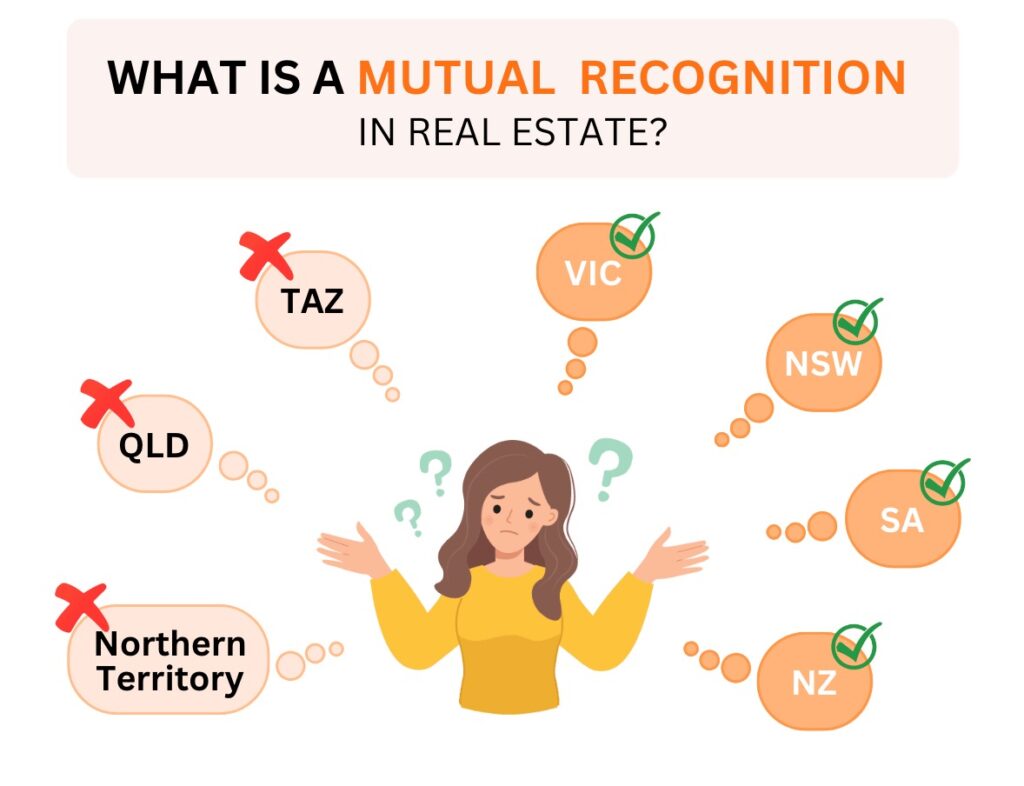Mutual recognition in real estate is when your credentials as a real estate professional are accepted automatically in other parts of Australia without the need to apply for a new licence.
But it’s not only within Australia. If you’ve ever dreamed about hopping across the Tasman and working in Auckland, Australia has negotiated a mutual recognition in real estate agreement with New Zealand as well.
How does mutual recognition work?
It’s simple, really.
If you have a valid Australian real estate qualification and want to work in an Australian state that’s part of the automatic mutual recognition (AMR) scheme, all you have to do is apply for recognition of your credentials.
Even if you don’t plan on moving interstate and simply want to work in the property industry somewhere else that’s part of the AMR scheme, automatic mutual recognition can apply to you.

To be activated in practice, this policy statement requires legislative authorisation in each participating jurisdiction. At the federal level, this activation was provided by the Mutual Recognition Amendment Act 2021 (Cth). Legislation at the state level now means this scheme is active in Victoria, New South Wales and South Australia. The Parliament of Western Australia is currently considering legislation that will bring this state into the scheme as of 1 July 2022.
Queensland and Tasmania, the ACT and the Northern Territory do not, as yet, participate in the AMR scheme for the real estate industry. These states and territories still require interstate property professionals to apply for a local licence. This will change over time as the parliaments or legislative assemblies of those states and territories pass the legislation necessary to activate AMR in their jurisdictions.
If you’ve ever dreamed about hopping across the Tasman to work in the New Zealand property sector, there’s a bilateral agreement for that. The ‘Trans-Tasman Mutual Recognition Arrangement 1996’ is a non-treaty statement of principles that extends mutual recognition to professional credentials earned in Australia and New Zealand. Like the Intergovernmental Agreement mentioned before, this arrangement only applies where activating legislation has been passed by the parliaments or legislative assemblies of Australian jurisdictions.
But first, let’s look closer to home at how AMR works in each participating Australian jurisdiction.
Automatic mutual recognition in Victoria
AMR in Victoria is authorised by the Mutual Recognition Act 1998 (Vic) and includes the following real estate-related professions:
- Conveyancers
- Estate agents
- Owners corporation managers
- Rooming house operators
Real estate professionals from jurisdictions included in the AMR scheme must notify the Victorian Business Licensing Authority before they commence work. They’ll be required to provide copies of their original interstate qualification documents before notification is considered complete.
Automatic mutual recognition in NSW
AMR in NSW is authorised by the Mutual Recognition (Automatic Licensed Occupations Recognition) Act 2014 (NSW).
The mutual recognition in real estate scheme extends to real estate agents and assistant agents/salespersons, strata managers and stock and station managers.
To access AMR in NSW you’ll have to take the following steps:
- All applicants will submit a Notification to Local Registration Authority form.
- Licensed real estate agents will submit an Interstate Mutual Recognition Application form.
- Registered assistant agents will submit an Application for Certificate of Registration form.
- All applicants must submit:
- personal and business details
- professional interstate licences and/or registration documents
- two valid forms of identification.
- Pay an application fee of $735 for one year, $1,387 for two years and $2,019 for three years.
Your application and fees may be submitted either online or in person at a Service NSW centre.
Automatic mutual recognition in South Australia
The Mutual Recognition Act 1993 (SA) establishes the legal framework for AMR in South Australia and includes the following real estate industry professions:
- Conveyancer
- Land agent
- Land sales representative
- Property manager
- Auctioneer
- Trainee
To apply for mutual recognition in South Australia for your interstate real estate qualification, you’ll need to submit a Safework SA Notification of Automatic Mutual Recognition form.
You’ll also be required to submit copies of your interstate licence, registration or documentation of other relevant qualifications.
Automatic mutual recognition with New Zealand
The Trans-Tasman Mutual Recognition Arrangement was signed in 1996 by the prime ministers of Australia and New Zealand along with the premiers/chief ministers of all Australian states and territories.
The Trans-Tasman Mutual Recognition Act 1997 (Cth) and Trans-Tasman Mutual Recognition Act 1997 (NZ) provided the activating legal framework for Australia-New Zealand automatic mutual recognition at the respective national levels. Equivalent activating legislation at the Australian state and territory level was enacted by the parliaments of Victoria, New South Wales, Queensland, Western Australia, South Australia, Tasmania, the ACT and Northern Territory.
If you are an Australian real estate professional who wants to apply for an equivalent New Zealand qualification under the Trans-Tasman Mutual Recognition Act, you must hold active Australian licences and/or registration at the time of application. Your application should be submitted to the New Zealand Real Estate Authority (NZREA).
The following documentation will be required in support of your application:
- Declaration in Support of Application for Licence on the Basis of the Trans-Tasman Mutual Recognition Act 1997 form.
- Evidence of your Australian licence or registration. A record of academic achievement, statement of attainment or qualification certificate will not be sufficient.
The NZREA will contact the government authority that issued your Australian licence and/or registration to verify the accuracy of your application. They will also enquire whether you have been subject to any professional disciplinary action.
It will take NZREA at least one month to process your application. But once the receipt of application is acknowledged you may begin to work in the New Zealand real estate industry on what is called a ‘deemed registration.’
The current cost of applying to NZREA for a New Zealand real estate licence currently costs NZ$939.55.
So let’s recap – What is mutual recognition in Real Estate?
Mutual recognition in real estate is an agreement between various states in Australia and New Zealand to recognise the value of the real estate credentials they all issue. And that means it’s your ticket to an exciting real estate career in a new location and new market if you so choose.
While every Australian state and territory has passed legislation that activates the AMR scheme in their jurisdiction, it is on all of their parliamentary to-do lists. So it’s just a matter of time before a real estate agent from Perth can start working in Parramatta, or a sales associate from Hobart can begin to sell property in Hobson’s Bay.
Questions? Ask Entry Education
At Entry Education we’re experts on what qualifications are required to work in the Australian real estate industry. If you have any questions about real estate courses in your state please contact us.














